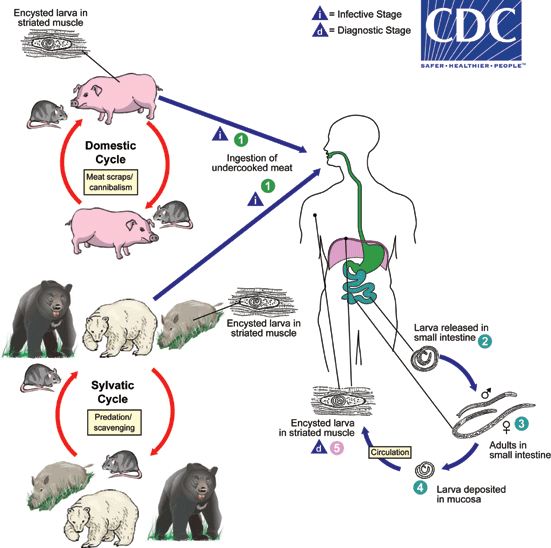
Trichinella Spiralis:
Trichinella species are the smallest nematode parasites of humans. Trichinella Spiralis, more commonly known as a threadworm or pork worm, is a nematode responsible for the disease trichinosis or trichinellosis [2]. It is usually caused by the consumption of unsanitary, undercooked , and infected meat, especially pork. Trichinella lodges itself in striated muscle cells. An estimated 10,000 cases of Trichinosis occur every year worldwide [5]. The disease is most commonly reported in animals rather than humans.
Symbiont Description:
Trichinella spiralis is part of the family Trichinellidae in the order Trichurida. Trichinella males measure between 1.4mm and 1.6mm long with a terminal anus [1]. Females of these species are two times as big as the males, also with a terminal anus. The esophagus of the female contains the vulva and the uterus in the posterior end contains developing eggs [1]. The anterior end of the nematode contains developed juveniles.

Host Description:
Species of Trichinella spiralis are most commonly found in pigs, rats or other wild game such as bears or cougars. Domestic pigs are very effective hosts and rats are usually the intermediate hosts. Humans, however, are considered accidental hosts. The reason for this is because humans cannot carry the parasite on to the next life cycle [6]. Pigs and rats, on the other hand, are able to carry the parasite on to its next life cycle by eating infected meat.

Life Cycle:
Trichinosis is caused by consuming infected meat containing cysts of Trichinella spiralis. These cysts are also known as nurse cells. As the cyst containing meat travels to the stomach, chemical signals caused by pepsin allow the cyst to release the larvae [6]. The meat then enters the intestine, where the chemical agent bile allows the larvae to move in a snakelike slither manner [6]. The larvae leave the meat and enter the intestine where they become adults. After one week, the adult females release larvae that find its way through the blood and lymphatic system to striated muscle cells where they lodge and form cysts. The female then dies and passes out of the host [1].The cycle is repeated once again when muscle meat containing cysts is consumed.
Ecology:
This parasite can be harmful to the host. In humans, Trichinella can cause minor symptoms such as nausea, vomiting, diarrhea, and abdominal pain [5]. Many of the symptoms of Trichinella are assumed to be a common illness such as the flu [5]. The parasite is most commonly diagnosed by a blood test and rarely through a muscle biopsy [5]. Cases of this parasite have decreased due to freezing meat. When meat such as pork is frozen, the larvae inside the cysts are killed.
An Example Of:
Trichinella uses a variety of chemical triggers to further its life cycle. The parasite is highly complex and uses chemical agents found inside the body to encounter the host. Two specific agents the parasite uses to release larvae into the host are pepsin and bile [6]. These chemical agents help the fitness of the parasite by allowing it to complete and repeat its lifecycle.
References:
1. http://en.wikipedia.org/wiki/Trichinella_spiralis
2. http://www.e-cleansing.com/parasites/threadworm-trichinella-spiralis-2.html
3. http://www.trichinella.org/
4. http://www.wormbook.org/chapters/www_genomesTrichinella/genomesTrichinella.html
5. http://www.cdc.gov/parasites/trichinellosis/
6. Zimmer, Carl. Parasite Rex. London: Arrow, 2000. Print.
No comments:
Post a Comment